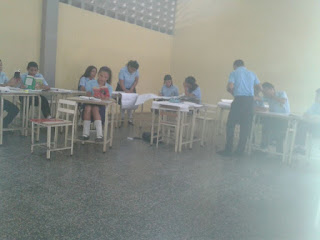A Case Study:
This case was observed
in the last school year, in 7th grade section D. Before starting
this English course, the teacher was more grammatical and strict in her form of
evaluation, even though in the way that she treated her students. Her face was
always serious and some rigorous; maybe those facts could influence in the
learners behavior; even they could promote some challenging students into the
class. Besides, the students just did what the teacher asked, but they did not
have any interaction among them taking into consideration the language as a
communicative tool. They just repeated and repeated all the structures given by
the teacher without any conscious about that English is a way of communication.
Even, they did not like to work in class; they always rejected to participate
during the class and work together; is to say learners did not have a good
attitude to learn English.
After starting the course and being applied some new
strategies into the classroom, which were adapted from the course to the
learners level, the teacher noticed a high difference in their attitudes toward
the language, because they began to be more independent in terms of using it. They
pronounced not so well but used more English in class, saying some words and
phrases which were given at the beginning of the school year. In the same way,
they began to communicate each other using a little bit more the language,
maybe they were not conscious about the process of communication but they could
exchange some phrases. It could be said that many of these learners could
constructive their own knowledge themselves. In my own opinion, I think their process
of learning was a little more effective than at the beginning of the first
lapse.
At the end of the school year, they were more
interested and motivated to the English language. They participated more actively
in class; also there were times in which they asked for activities to do in
class.
It is important to take conscious
about that learners are not robots who just receive information; they are
persons who think and feel. We as teachers must be aware and be clear in the
way that they learn; otherwise teachers must not be repetitive, because young
learners tend to bored quickly. By this, teachers should considerate the best
strategies and techniques to be applied. They must be the most appropriate
according to the levels of learners taking into account their kind of behavior.





